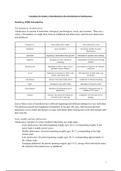Literature for lecture 1 Introduction to the development of adolescence
Steinberg (2020) Introduction
The boundaries of adolescence
Adolescence is a period of transitions: biological, psychological, social, and economic. There are a
variety of boundaries we might draw between childhood and adolescence, and between adolescence
and adulthood:
Perspective when adolescence begins when adolescence ends
biological onset of puberty becoming capable of sexual
reproduction
emotional beginning of detachment from parents attainment of separate sense identity
cognitive emergence of more advanced consolidation of advanced reasoning
reasoning abilities
interpersonal beginning of shift in interest from development of capacity for intimacy
parental to peer relations with peers
social beginning of training for adult work, full attainment of adult status and
family, and citizen roles privileges
educational entrance into junior high school completion of formal schooling
legal attainment of juvenile status attainment of majority status
chronological attainment of designated age of attainment of designated age of
adolescence adulthood (21 years)
cultural entrance into period of training for completion of ceremonial rite of
ceremonial rite of passage passage
Each of these series of transitions have different beginnings and different endings for every individual.
The adolescent period has lengthened considerably in the past 100 years, both because physical
maturation occurs earlier and because so many individuals delay entering into work and marriage until
their mid-20s.
Early, middle, and late adolescence
Adolescence contains of a series of phases rather than one single stage.
- Early adolescence: the period spanning roughly ages 10-13, corresponding roughly to the
junior high or middle school years;
- Middle adolescence: the period spanning roughly ages 14-17, corresponding to the high
school years;
- Late adolescence: the period spanning roughly ages 18-21, corresponding approximately to
the college years;
- Emerging adulthood: the period spanning roughly ages 18-25, during which individuals make
the transition from adolescence to adulthood.
1
,Studying adolescence
A model that studies adolescence by John Hill (1983), has three basic components:
1. The fundamental changes of adolescence;
2. The contexts of adolescence;
3. The psychosocial developments of adolescence.
1. The fundamental changes of adolescence
According to the model, three features of adolescent development give the period its special flavor
and significance (these three sets of changes are universal changes):
1. The onset of puberty (biological)
a. The biological changes are referred as puberty. It involves changes in the young
person's physical appearance and the development of the ability to conceive children
2. The emergence of more advanced thinking abilities (cognitive)
a. The word cognitive refers to the processes that underlie how people think. Compared
with children, adolescents are much better able to think about hypothetical situations.
3. The transition into new roles in society (social)
a. Social transitions consists of changes in rights, privileges, and responsibilities.
2. The contexts of adolescence
The psychological impact of the biologica, cognitieve, and social changes of adolescence is shaped by
the environment in which the changes take place: psychological development during adolescence is a
product of the interplay between a set of three very basic, universal changes and the context in which
these changes are experienced.
Another component of the context, is the ecological perspective on human development
(Bronfenbrenner, 1979). According to this perspective, there are four main contexts in which young
people spend their time: families, peer groups, schools, and work and leisure times. These contexts of
adolescence are themselves shaped and defined by the larger society in which young people live.
3. Psychosocial development in adolescence
There are a few basic developmental challenges in the psychosocial development:
- Discovering and understanding who we are as individuals (identity)
- Experimentation: trying on different personalities in an attempt to discover one's true
self. Also, adolescents seek for recognition from others.
- Establishing a healthy sense of independence (autonomy)
- Three aspects of autonomy are of special importance during adolescence: (1)
becoming less emotionally dependent on parents, (2) learning to function
independently, and (3) establishing a personal code of values and morals.
- Forming close and caring relationships with others (intimacy)
- Friendships emerge that involve openness, honestly, loyalty, and exchange of
confidences, rather than simply a sharing of activities and interests.
- Expressing sexual feelings and enjoying physical contact with others (sexuality)
- There are several concerns about these kind of challenges. These concerns include
incorporating sexuality into a still-developing sense of self, understanding one's
sexual orientation, resolving questions about sexual values and morals, and coming to
terms with the sorts of relationships into which the adolescent is prepared to enter.
2
, - Being successful and competent members of society (achievement)
- Crucial decisions - many with long-term consequences - about schooling and careers
are made during adolescence.
Theoretical perspectives on adolescence
1. Biosocial theories
This theory stresses the hormonal and physical changes of puberty as driving forces. The most
important biosocial theorist was G. Stanley Hall (1904), considered the ¨father¨ of the scientific study
of adolescence.
In Hall´s theory of recapitulation, he believed that the development of the individual paralleled the
development of the human species. Adolescence was seen as a time that paralleled the evolution of
our species into civilization. The most important legacy of this theory is the notion that it is inevitably
a period of ¨storm and stress¨: the hormonal changes of puberty cause upheaval, both for the
individual and for those around him or her. Hall believes that adolescence is inherently problematic.
Dual systems theories stresses changes in the anatomy and activity of the brain. Specifically, it
stresses the simultaneous development of two different brain systems, one that governs the ways in
which the brain processes rewards, punishments, and social emotional information, and another that
regulates self-control and advanced thinking abilities, like planning or logical reasoning. The main
challenge of adolescence, according to this view, is to develop better self-regulation, so that this
imbalance does not result in problems.
2. Organismic theories
Like biosocial theorists, organismic theorists recognize the importance of the biological changes of
adolescence, but unlike their biosocial counterparts, organismic theories also take into account the
ways in which contextual forces interact with and modify these biological forces. Three of these
theorists have had a great influence on the study of adolescence:
- Sigmund Freud (1938). According to Freud, development was best understood in terms of the
psychosexual conflicts that arise at different points in development. Like Hall, Freud saw
adolescence as a time of upheaval. Puberty temporarily throws the adolescent into a period of
psychological crisis, by reviving old conflicts over uncomfortable sexual urges that had been
buried in the unconscious.
- Erik Erikson (1963). Like Freud, Erikson also believed that internal, biological developments
moved the individual from one developmental stage to the next. But unlike Freud, Erikson
stressed the psychosocial rather than the psychosexual, conflicts faced by the individual. In
this theory, development in adolescence revolves around the identity crisis.
- Jean Piaget (1958). According to Piaget, development could best be understood by examining
changes in the nature of thinking. As children mature, they pass through distinct stages of
cognitive development, whereby adolescence marks the transition from concrete to abstract
thought.
3. Learning theories
This group of theorists begins to shift the emphasis from biological forces to environmental ones.
Learning theorists stresses the context in which behavior takes place. According to these theorists, the
basic processes of human behavior are the same during adolescence as during other periods of the life
span. There are two general categories of learning theorists:
3
, - Behaviorism: they emphasize the processes of reinforcement and punishment as the main
influences on adolescents behavior. The main proponent of this view was Skinner (1953),
with the theory of operant conditioning. Reinforcement is the process through which a
behavior is made more likely to occur again, whereas punishment is the process through
which a behavior is made less likely to occur again.
- Social learning theory: they place more weight on the processes of observational learning and
imitation.
4. Sociological theories
Sociological theories of adolescence attempt to understand how adolescents, as a group, come of age
in society. Sociological theorists focus on the factors that all adolescents or groups of adolescents
have in common by virtue of their age. Two themes have dominated these discussion:
- Adolescent marginality: it stresses the fact that because adolescents are often prohibited from
occupying meaningful roles in society, young people often become frustrated and restless.
From this view, the problem lies in how we treat adolescents as if they are more immature
than they actually are and isolating them from adults.
- Intergenerational conflict: is stresses the fact that adolescents and adults grow up under
different social circumstances and therefore develop different sets of attitudes, values, and
beliefs. As a consequence, there is inevitable tension between the adolescent and the adult
generation.
5. Historical and anthropological perspectives
The historical perspective stress that adolescence as a developmental period has varied considerably
from one historical era to another. As a consequence, it is impossible to generalize about such issues
as the degree to which adolescence is stressful, the developmental tasks of the period, or the nature of
intergenerational relations: it depends on the social, political, and economic forces present at a given
time.
- Adolescence as an invention: adolescence is entirely a social invention. The way in which we
divide the life cycle into stages is nothing more than a reflection of the political, economic,
and social circumstances in which we live. Social conditions, nog biological givens, define
the nature of adolescent development.
- Anthropological perspectives: societies vary considerably in the ways in which they view and
structure adolescence. As a consequence, these thinkers viewed adolescence as a culturally
defined experience, stressful and difficult in societies that saw it this way, but calm and
peaceful in societies that had an alternative vision.
Steinberg (2020) Chapter 3 Social transitions
Social redefinition and psychosocial development
Social redefinition is referred as the process through which an individual's position or status is
redefined by society. In adolescence, responsibilities and freedom increases, and this has an impact on
the development of autonomy, or independence: the adolescent faces a wide range of decisions that
may have serious long-term consequences.
4






